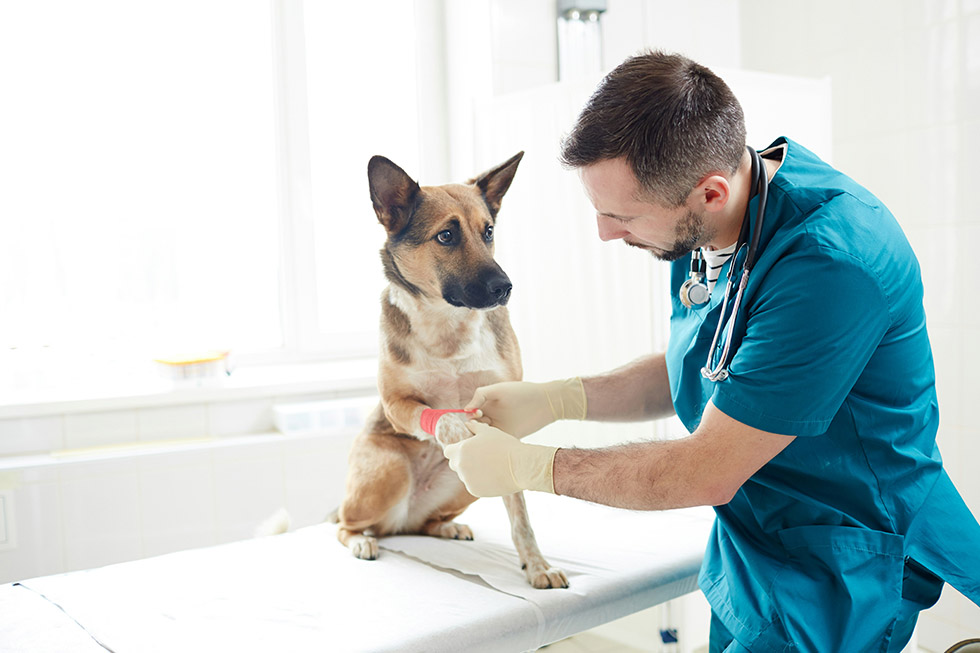
Soft Tissue Trauma in Dogs
Soft tissue trauma in dogs is a prevalent concern among pet owners, often resulting from accidents or injuries. Understanding this condition and its implications is crucial for providing timely care and ensuring your furry friend’s well-being. Pet Insurance Australia explores the various aspects of soft tissue trauma in dogs, including its causes, symptoms, and treatment options.
What is Soft Tissue Trauma in Dogs, and Why is it a Concern?
Soft tissue trauma is damage sustained by muscles, ligaments, tendons, or other soft tissues in the body. Some of our most common claims at Pet Insurance Australia are due to soft tissue trauma. This type of injury can occur in dogs for various reasons, including falls, collisions, or even repetitive strain. While some cases may result in minor discomfort, severe trauma can lead to significant pain and mobility issues, affecting your dog’s quality of life.
The Common Causes of Soft Tissue Trauma in Dogs
Soft tissue trauma in dogs can be caused by various factors, including sudden accidents, strenuous physical activities like jumping or twisting, or even underlying health conditions. Common causes include falls, collisions with objects or other dogs doing zoomies at the off-leash park, overexertion during exercise, and repetitive motions that strain the muscles or joints.
The Symptoms of Soft Tissue Trauma in Dogs
Identifying the symptoms of soft tissue trauma in dogs is essential for prompt diagnosis and treatment. Common signs include limping or favouring a specific leg, swelling or bruising in the affected area, reluctance to move or bear weight, and signs of pain or discomfort when touched. In severe cases, dogs may exhibit signs of distress, such as whimpering or vocalising. If your dog has suffered any soft tissue trauma, it is highly recommended that you seek help from a veterinarian to examine your pet and discuss the best treatment plan to ensure your pet is not in pain.
The Options for Treatment and Recovery of Soft Tissue Trauma in Dogs
Treatment options for soft tissue trauma in dogs vary depending on the severity of the injury. Mild cases may require rest, anti-inflammatory medication, and supportive care to aid recovery. In more severe cases, surgical intervention or physical therapy may be necessary to repair damaged tissues and restore mobility. Rehabilitation exercises, such as controlled movement and hydrotherapy, can also play a crucial role in recovery.
The Role of Vet Care in Treating Soft Tissue Trauma in Dogs
Veterinary care is essential for effectively diagnosing and treating soft tissue trauma in dogs. A thorough physical examination, along with imaging tests such as X-rays or ultrasounds, may be required to assess the extent of the injury and develop a suitable treatment plan. Your veterinarian will work closely with you to monitor your dog’s progress and adjust the treatment as needed to ensure the best possible outcome. It is good to remember that dogs are masters at masking their pain, particularly in soft tissue trauma. It is common to hear of a dog limping one day but seemingly better the next, only to feel pain again a few days later. So, if you suspect that your dog is in any discomfort, it is always best to get an expert’s advice in terms of treatment.
How Pet Insurance Can Help with the Cost of Treating Soft Tissue Trauma in Dogs
Pet insurance can be a valuable resource for managing the financial burden of treating soft tissue trauma in dogs. With pet insurance, pet owners may be able to access help for coverage of a portion of eligible vet bills if the unexpected happens. Pet insurance can assist with a wide range of treatment costs, from diagnostic tests, medications, and surgical procedures,* allowing you to focus on your dog’s recovery with less financial stress. Reading the Product Disclosure Statement to check if the policy is right for you and your family is highly recommended.
What to Look for in a Pet Insurance Policy for Soft Tissue Trauma in Dogs
When selecting a pet insurance policy for soft tissue trauma in dogs, it’s essential to consider several factors to ensure adequate coverage. Look for a policy that offers coverage for accidents and injuries, including soft tissue trauma. Pay attention to coverage limits, deductibles, and exclusions to understand the extent of the coverage provided. Additionally, consider the reputation and reliability of the insurance provider, as well as any additional benefits or perks offered, such as non-insurance benefits.
Filing a Pet Insurance Claim for Soft Tissue Trauma in Dogs
If your dog experiences soft tissue trauma, filing a pet insurance claim can help offset the cost of veterinary care. To file a claim, gather all relevant documentation, including medical records, invoices, and receipts for treatments and medications. Follow the insurance company’s guidelines for submitting claims, ensuring all necessary information is provided accurately and promptly. Be prepared to communicate with the insurance provider and provide additional information or documentation to expedite the claims process. To learn more about how to claim soft tissue trauma in dogs with Pet Insurance Australia, take a look here.
* Limits, waiting periods, exclusions and excesses may apply.

Preventing Soft Tissue Trauma In Dogs
Soft tissue trauma in dogs can lead to pain, discomfort, and mobility issues for our beloved furry friends. While accidents and injuries are sometimes unavoidable, there are steps pet owners can take to minimise the risk of soft tissue trauma and promote their dog’s overall well-being. In this blog post, we’ll explore essential tips for preventing soft tissue trauma in dogs and ensuring a safe and healthy lifestyle for your canine companion.
- Maintain a Healthy Weight – Obesity can strain a dog’s joints and soft tissues unnecessarily, increasing the risk of injuries such as sprains and strains. Ensure your dog maintains a healthy weight through a balanced diet and regular exercise to prevent soft tissue trauma. Consult your veterinarian to develop a suitable feeding plan and exercise regimen tailored to your dog’s needs.
- Provide Adequate Warm-Up and Cool-Down – Dogs benefit from proper warm-up and cool-down routines before and after physical activity. Before strenuous exercise or activities, warm up your dog’s muscles with gentle movements and stretches. Similarly, allow a gradual cool-down period to prevent sudden muscle strain and reduce the risk of soft tissue injuries.
- Use Proper Equipment During Exercise – When engaging in physical activities such as running, hiking, or playing fetch, use appropriate equipment to support your dog’s joints and minimise the risk of soft tissue trauma. Invest in a well-fitted harness or collar that provides adequate support without restricting movement. Additionally, use a sturdy leash to maintain control and prevent sudden movements or jolts that could lead to injury.
- Avoid Overexertion – While regular exercise is essential for a dog’s physical and mental well-being, avoiding overexertion is crucial, especially for breeds prone to joint or muscle issues. Pay attention to your dog’s cues during physical activity and allow sufficient rest periods to prevent fatigue and muscle strain. Adjust the intensity and duration of exercise based on your dog’s age, fitness level, and overall health.
- Provide Safe and Supportive Environments – Create a safe and supportive indoor and outdoor environment for your dog to minimise the risk of accidents and injuries. Remove potential hazards such as sharp objects, slippery surfaces, or obstacles that could cause trips or falls. Provide comfortable bedding and resting areas that offer adequate support for your dog’s joints and muscles, especially for older or arthritic dogs.
- Regular Veterinary Check-Ups – Schedule regular veterinary check-ups to monitor your dog’s overall health and address any potential issues before they escalate into more significant problems. Your veterinarian can assess your dog’s musculoskeletal health, recommend preventive measures, and provide guidance on maintaining optimal weight and fitness levels to reduce the risk of soft tissue trauma.
Incorporating these preventive measures into your dog’s daily routine can significantly reduce the risk of soft tissue trauma and promote your beloved canine’s overall well-being. Remember to prioritise your dog’s safety during physical activities, provide a supportive environment, and seek veterinary care to ensure a happy, healthy, and active life for your canine companion.
Nadia Crighton is a renowned and accomplished professional in the fields of Journalism, Public Relations, and Writing, with an extensive career spanning over 25 years, 20 of which have been dedicated to promoting the health and well-being of pets.
Get the latest Pet Insider Tips & News
We offer award-winning* pet insurance policies to protect your furry friend’s health and wellbeing. Get a quote today and give your pets the care they deserve.
Archives
Categories
- Cat Care (64)
- Cats (1)
- Dog Care (124)
- Guides (28)
- Health and Nutrition (200)
- Lifestyle and Activities (218)
- Media Release (23)
- Pet Care (246)
- Rescue Dogs (1)


